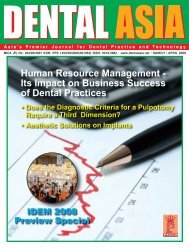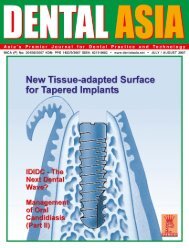Download - Dental Asia
Download - Dental Asia
Download - Dental Asia
You also want an ePaper? Increase the reach of your titles
YUMPU automatically turns print PDFs into web optimized ePapers that Google loves.
CLINICALFEATURE<br />
renal and arrhythmia risks. Future safety monitoring is<br />
warranted and may benefit from an active and continuous<br />
cumulative surveillance system. (Zhang et al 2006)<br />
Opoids are agent that binds to opioid receptors, found<br />
principally in the central nervous system and gastrointestinal<br />
tract. There arefour broad classes of opioids:<br />
1. endogenous opioid peptides, produced in the body; (eg<br />
endorphins)<br />
2. opium alkaloids, such as morphine (the prototypical opioid)<br />
and codeine;<br />
3. semi-synthetic opioids such as heroin and oxycodone<br />
4. fully synthetic opioids such as pethidine and Fentanyl;<br />
Tramadol that have structures unrelated to the opium<br />
alkaloids (Fentanyl)<br />
The non-clinical use and off-label clinical use were criminalized in<br />
the USA by the Harrison Narcotics Tax Act of 1914, and by other<br />
laws worldwide. In USA, the Controlled Substances Act of 1970<br />
markedly relaxed the harshness of the Harrison Act. Opoids act<br />
on the following opioid receptors in the nervous system:<br />
Pharmaco Sci 1993) The common steroids used in dentistry<br />
are Dexamethasone and Prednisolone.<br />
Enzymes for anti inflammatory are a naturally occuring<br />
protease enzyme that digests non-living tissue, blood clots,<br />
cysts, and inflammation in all forms. The common ones are:<br />
1. Serrapeptidase: It acts via the hydrolysis of peptides into<br />
amino acids. It is a powerful proteolytic enzyme obtained<br />
from silkworms<br />
2. Papain: It is also known ascysteine protease (EC 3.4.22.2)<br />
and ispresent in papaya (Carica papaya) which is useful in<br />
tenderizing meat and other proteins.<br />
The exact mode of Action is unknown. However, preliminary<br />
studies show some potential in inflammation reduction. It is<br />
concluded that Serratia peptidase has anti-inflammatory, antioedemic<br />
and fibrinolytic activity and acts rapidly on localized<br />
inflammation. (Mazzone A et al, 1990 J Int Med Res)<br />
Finally, here is a diagram of the inflammatory process and the<br />
action of drugs used in dentistry for pain management.<br />
1. MU<br />
2. Delta (still in discussion)<br />
3. Kappa<br />
4. Sigma-<br />
5. Epsilon (still in discussion)<br />
Common adverse reactions include: tolerance, dependence<br />
and withdrawal issues, nausea and vomitting, drowsiness,<br />
dizziness, headache, orthostatic hypotension, itch, dry mouth,<br />
miosis, urinary retention, and constipation. (Rossi, 2005).<br />
Tolerance can be detected within 12-24 hours of the<br />
administration of morphine (Rang et al, 2003) and results in the<br />
necessity for increasing the dose over time to achieve the<br />
desired clinical effect. It appears to develop first to the<br />
analgesic, sedative, emetic, euphoric and respiratory<br />
depressive effects of opioids. The miotic and constipating<br />
effects are more resistant to the development of tolerance.<br />
(Rang et al, 2003)<br />
For anti-inflammatory drugs, the following are used:<br />
1. Steriods<br />
2. Enzymes, eg Serro-peptidase<br />
3. NSAIDs (as discussed earlier)<br />
Steriods are terpenoid lipid characterized by a carbon skeleton<br />
with four fused rings. All steroids, being terpenoids, are derived<br />
from HMG-CoA which itself is derived from the acetyl CoA<br />
biosynthetic pathway. For anti-inflammtory, these are usually<br />
Glucocorticoids. The mode of action is (Anti-inflammatory<br />
mechanism) by decreasing gene transcription of cytopkines,<br />
chemokines, inflammtory enzymes, decreasing T/B cells,<br />
macrophages,direct vasoconstriction. (Barnes PJ Trends<br />
Legends<br />
-----------------<br />
Confirmed mode of action<br />
Associated mode of action<br />
Dr Bertrand Chew has a Masters in Oral and<br />
Maxillofacial Surgery and is a Fellow of the Royal<br />
Australian College of <strong>Dental</strong> Surgeons. Currently,<br />
he is working with the Singapore Armed Forces as<br />
an Oral Maxillofacial Surgeon. He also lectures on<br />
the FDI <strong>Asia</strong>-Pacific circuit and is active with the<br />
Singapore <strong>Dental</strong> Association.<br />
42 <strong>Dental</strong> <strong>Asia</strong> • May / June 2008





